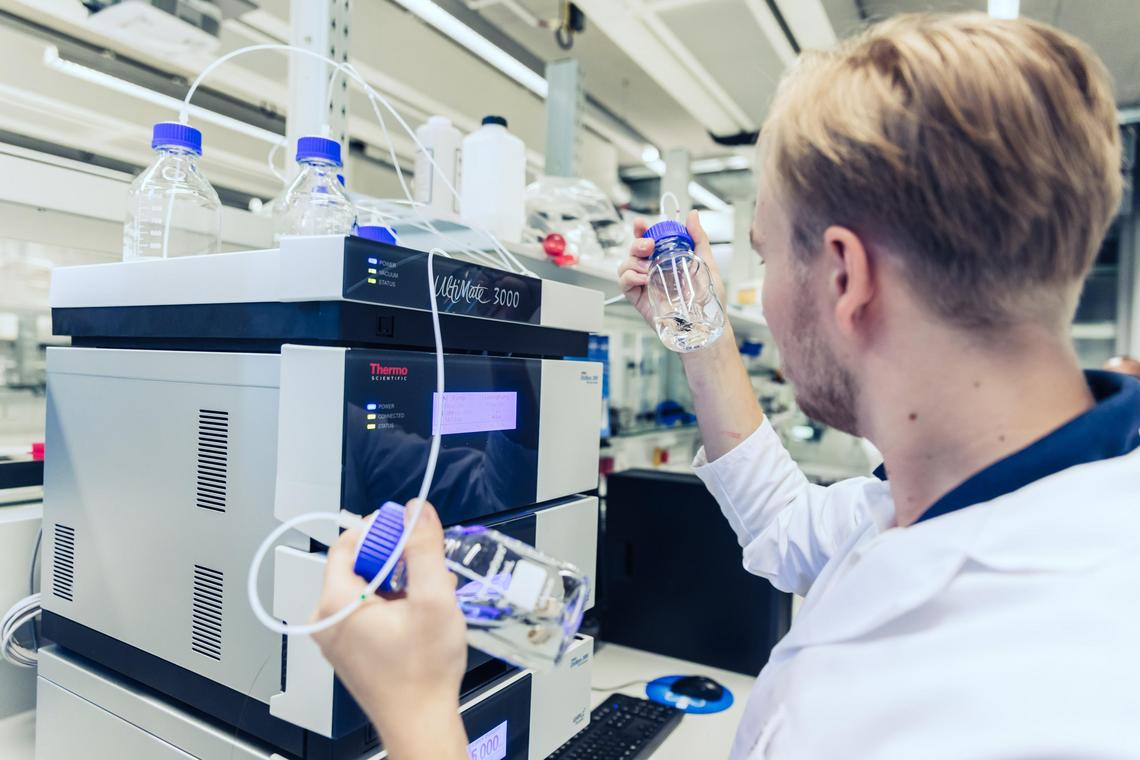Press
Innovative research approach for cancer therapy

Using an innovative research method, the identification of target proteins for the potential anti-tumor drug rhenium tricarbonyl (TRIP) in ovarian cancer cells was successfully achieved. Of the 89 proteins identified using chemoproteomics, the scaffold protein NUBP2 could be identified as a promising target for the recently discovered antitumor drug. These are the results of a scientific study by an international research team from the University of Vienna, Austria and Cornell University, USA around Benjamin Neuditschko, now a scientist at IMC Krems, which was recently published in the journal Angewandte Chemie International Edition. In it, they analyzed in more detail the cancer cell proteins TRIP interacts with and also the effects of different TRIP doses on the entire set of cancer cell proteins. The data thus obtained indicate that NUBP2 acts as a starting point for TRIP-induced cell death of cancer cells and that the potential drug is already effective at a very low dose.
In the development of anti-tumor drugs, the identification of target proteins as a starting point for the active agent in the cancer cells is important. In this way, potential polypharmacologies – the effect on multiple proteins – can be uncovered and potential side effects kept to a minimum. A new method for such identification is chemoproteomics. This is a key technology for characterizing the mode of action of drugs to determine which cellular proteins the drug affects. To identify a promising target protein candidate in ovarian cancer cells, an international research team led by Dr. Neuditschko, currently a scientist at IMC Krems, designed a study based on chemoproteomics. This helped to clarify the question of which proteins interact with the recently discovered anti-tumor agent rhenium tricarbonyl (TRIP) and how TRIP affects the composition of the proteome – the entire set of all cell proteins.
Smart study design identifies 89 target proteins
"For our study, we considered a new and combined research approach by, on the one hand, performing chemoproteomic studies on cancer cell lysates with different TRIP doses and, on the other hand, also looking at the effects of TRIP treatment on living ovarian cancer cells," explains Benjamin Neuditschko. "In this way, we were able to identify a total of 89 target proteins in a dose-dependent manner and also find out on which of these proteins TRIP acts most efficiently."
Scaffold protein NUBP2 is promising candidate for TRIP
The complex analysis of the 89 possible target proteins for TRIP narrowed the selection down to two proteins. Of these, the scaffold protein NUBP2 ultimately proved to be the most promising because it interacts with the drug even at very low and non-cytotoxic TRIP doses. NUBP2 is involved in metabolic processes in cancer cells that are important for their survival: If this protein is competitively inhibited by TRIP, this ultimately leads to cell death (apoptosis) of the tumor cells. "More specifically," Dr. Neuditschko elaborates, "NUBP2 is a biogenesis factor that is essential for the production of proteins with iron-sulfur clusters, which play a role as co-factors in many essential cellular metabolic processes. Treatment of ovarian cancer cells with nanomolar – i.e., very low – concentrations of TRIP leads to a drastic reduction in Fe-S proteins, preventing processes essential for survival, such as cellular respiration, from taking place and causing tumor cell death."
The insights gained from this preclinical study are of interest for further research in that TRIP, via inhibition of NUBP2, interferes with the biogenesis of Fe-S clusters in tumor cells even at very low and therefore not generally cytotoxic doses – an important factor in the search for anticancer drugs that are as specific and side-effect-free as possible.
Research at an excellent level
Benjamin Neuditschko and his team conducted the research for this current study at the University of Vienna and Cornell University. His further career path has now led Dr. Neuditschko to the Institute Krems Bioanalytics, where he can further expand his expertise in the field of preclinical analytics and make it available to industry - and thus to "applied research". The institute has been offering contract research for industry and academic institutions since 2014. Specializing in innovative bioanalytical services, the institute has strong expertise in tailored immunogenicity assessments, investigating adverse effects and side effects of protein therapeutics on the immune system. Data are collected in preclinical and clinical studies and are used by regulatory authorities for drug evaluation and assessment. In order to meet the associated high requirements, quality assurance is carried out according to the industry standards Good Laboratory Practice (GLP) and Good Clinical Practice (GCP), which are continuously reviewed by the Austrian Agency for Health and Food Safety (AGES), by international regulatory authorities or by industry. Thus, the Institute Krems Bioanalytics is one of few institutions in Austria that can offer quality-assured contract research for the pharmaceutical industry at the highest level. With the successful acquisition of an FFG grant for their project "Biomedical Proteomics for the Characterization of the Human Immune Response for the Targeted Development of Biotherapeutics", Benjamin Neuditschko and Franz Herzog are now working on the establishment of a laboratory for Biomedical Mass Spectrometry at the Institute Krems Bioanalytik. Here, research will be conducted on methods for characterizing the human immune response at the molecular level, thus creating the basis for the targeted development of efficient immunotherapies.
Original publication: An Anticancer Rhenium Tricarbonyl Targets Fe−S Cluster Biogenesis in Ovarian Cancer Cells.
Benjamin Neuditschko, A Paden King, Zhouyang Huang, Lukas Janker, Andrea Bileck, Yasmin Borutzki, Sierra C Marker, Christopher Gerner, Justin J Wilson, Samuel M Meier-Menches. Angewandte Chemie International Edition 2022 Oct 24;61(43):e202209136. DOI: 10.1002/anie.202209136
